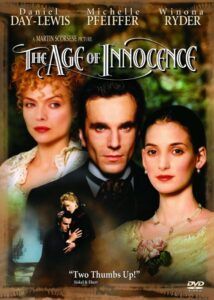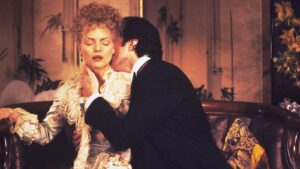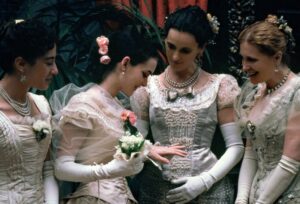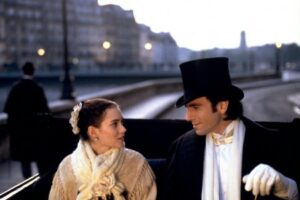“The Age of Innocence” – Desire in New York

Title: “The Age of Innocence”
Release Date: 1993
Director: Martin Scorsese
Cast: Daniel Day-Lewis, Michelle Pfeiffer, Winona Ryder, Richard E. Grant, Geraldine Chaplin
“The Age of Innocence” by Martin Scorsese is a great adaptation of Edith Wharton’s most famous 1920 novel. The first-ever Pulitzer Prize-winning writer created in her book a complex picture of the New York elite of the late 19th century. Full of glitz and luxury, the world of the American aristocracy appears as a trap of tight conventions, where love cannot stand above the financial and social interests of the clan. Love’s desire is thus doomed to eternal unsatisfaction, and a great career and money become compensations for unfulfilled desires. This is how Scorsese reads Wharton’s novel, offering as much a nostalgic as an irony-laden portrayal of fiery affection and the dying world of the founders of New York socialite.
“The Age of Innocence” – New York at the end of the 19th century
The plot of the film “The Age of Innocence” is set in the 1870s in New York. Here the beautiful Countess Ellen Olenska (Michelle Pfeiffer) appears in the theater, electrifying the world of American aristocracy. For there is a social scandal behind Madame Olenska: the woman has left her sadistic husband, a wealthy Polish aristocrat, and returned to her hometown. The entire New York elite receives the countess with scorn and refuses to host her in their salons. The situation is changed only by a young aristocrat, Newland Archer (Daniel Day-Lewis), who fears that the countess’s affair may reflect negatively on the reputation of his fiancée and also Olenska’s cousin, May Welland (Winona Ryder). The man therefore seeks to arrange a party allowing Ellen to re-enter society. As a lawyer employed by a well-known law firm, he simultaneously handles the Countess’s divorce case, ultimately advising her against permanently ending her marriage, which would worsen her situation.
Newland becomes increasingly close to Olenska, succumbing to her extraordinary charm, and she reciprocates his affection. Trying to forget this love, the man speeds up his marriage to May, but the marriage only deepens his crisis. Passion for Ellen, whom Archer meets in various social settings, painfully grows, and he comes close to leaving his wife. Finally, the Countess promises Newland to spend the night together and sends him the key to her house. Nevertheless, just before the scheduled soiree, it turns out that May is pregnant and that she has already notified Olenska of everything. The countess, not wanting to complicate the situation, leaves for Europe. Thirty years later, after May’s death, Newland arrives with his adult son in Paris, where they both receive an invitation from Countess Olenska. At the last minute, however, the man gives up on entering Ellen’s house and leaves.

“The Age of Innocence” – a nostalgic chronicle of New York in the style of Luchino Visconti
Martin Scorsese shot “The Age of Innocence” with extraordinary panache. The production cost as much as $30 million, and the impressive budget was used to faithfully render the finest details of the 19th century American metropolis. Who could have done this with more passion than Scorsese, a lover and tireless portraitist of the legend of New York. Thus, a magnificent gallery of historic interiors of the American aristocracy stretches before the viewer’s eyes. Lavish salons full of antiques and collections of paintings, a ballroom with a phenomenal chandelier, detailed filming of sumptuous culinary specialties served on exclusive china, with silverware and magnificent crystals.
This sumptuousness in composing the historical image of New York in “The Age of Innocence” is reminiscent of the great works of Luchino Visconti. Impressive set design and Oscar-winning period costumes are complemented by wonderfully planned lighting. The glow of lamps and candles creates a kind of boudoir atmosphere reminiscent of Baroque and Rococo paintings. The aforementioned means of expression emphasize the distinctly nostalgic atmosphere of a world that is receding into the past. It is also co-created by the narrative treatment used in the film: the course of the action in many scenes is reported by a voice from behind the camera, belonging to the mature Joanne Woodward and imitating the narration of the writer.
“The Age of Innocence” – love in the web of conventions
Nevertheless, the blitz of the luxurious world of New York socialite in “The Age of Innocence” is superficial. For underneath it hides an intricate web of social conventions and conventions that so tightly entwine the individual that they almost destroy his individual desires. The flamboyant love between a would-be divorcee and a bachelor from a good family does not fit into the mores of this milieu. Seemingly free – a young wealthy man can’t quite dispose of his feelings freely, even though he boasts in conversation with Olenska that in America, unlike in Europe, marriages are not arranged. Newland knows that love for Ellen comes with a price, and he doesn’t want to afford it.

The protagonist’s entrapment is most clearly emphasized by the symbolic scene of the farewell dinner just before Olenska’s departure. Newland sits opposite his wife surrounded by his family – they are separated by a huge, lavishly set table, but despite this distance, the protagonist is somehow hostage to his position as head of the clan, from which he can by no means free himself. His guards are even the servants who appear in the frame, vigilantly watching what happens during dinner. In turn, the narrator of the story makes the telling statement, “His separation from his complicit partner was accomplished… He was a prisoner in the middle of an armed encampment.”
Also significant in this context is the method of handling light, which differs from that generally used, in scenes that are particularly significant for the development of the romance. During Newland and Ellen’s conversation in the theater and when Archer reads a letter from the Countess, stage lighting was used – when a single spotlight brings the characters out of the darkness, which not only conveys the intimate nature of their relationship, but also emphasizes that they are peculiar outsiders in the New York milieu.
The unfussy Newland Archer and the phenomenal Ellen Olenska
The role of Daniel Day-Lewis is phenomenal. The actor brilliantly conveys both the gradual succumbing to Ellen’s charms and the character’s flitting between growing desire and social role. Michelle Pfeiffer’s performance as Countess Olenska is equally wonderful on screen – she is phenomenally beautiful, ethereal and insanely fascinating. She represents an almost exotic allure, a real breath of fresh air in an environment that is artificial and dominated by empty rituals. Olenska stands out from other ladies not only by her beauty, but also by her sincerity. She openly expresses her feelings and even has the courage to cry in Newland’s presence. This naturalness is matched by her costumes – much simpler and less grandiose than those of the other heroines.

It is also worth noting in what kind of setting Ellen usually appears in “The Age of Innocence”. Well, most often it is a private space (her home or a private visit) and a space of nature. Newland visits her while in the countryside, where together they take a long walk in the winter landscape, and at other times the protagonist follows his beloved to the harbor, where he watches the woman from afar, seeing her against the backdrop of the sea waves and sunset.
These scenes are extremely rare in a film where most of the action takes place in enclosed spaces: glamorous New York homes, halls and offices. Thus, it is clearly emphasized that Archer and Ellen’s love is not within the bounds of the recognized norm, but also that it is the only scrap of true freedom. The countess herself, on the other hand, is certainly an unremarkable character, whose difficult life experiences complete the image of an intelligent and insightful woman. All the more so, therefore, Olenska’s affection for Archer appears as, on the one hand, deep, and, on the other, marked by the fatality of unfulfillment.
May – an innocent angel or a cunning woman?
An extremely interesting creation is also in “The Age of Innocence” the Golden Globe-winning role of Winona Ryder. May is namely an ambiguous character. At first, she appears as the embodiment of kindness and tenderness, and Archer is convinced that his fiancée has no idea about New York intrigues and does not participate in them in any way. She is pure innocence, to which Newland attributes a total lack of imagination after talking about speeding up the wedding. Meanwhile, May is certainly far from naïve, or at least she learns very quickly and evolves from a docile companion letting herself be controlled to a woman taking control through behind-the-scenes methods.
This is evidenced by the extraordinary acceleration of the wedding, which she allegedly refuses to do, but then very quickly obtains it. Later, on the other hand, after marrying Archer, May suspects her husband of having an affair with her cousin Olenska, so, contrary to the facts, he informs her of his pregnancy, so that she removes herself from their lives. In turn, the moment when the heroine, really expecting a child at the time, announces this news to Newland is particularly significant. The camera almost in slow motion shows May rising from her sitting position, a telling metaphor for the change in her position in the relationship and in the community. Now she is the one taking control and will not let it be taken away from her.

“The Age of Innocence” – the irony of the title, or the double face of the story and its characters
Perhaps the most interesting layer of both the novel and the film “The Age of Innocence” is the presence of irony, which gives all the elements (the title, the plot, the characters) an ambiguous dimension. The title of the book itself has been read ironically from the beginning, as a commentary by the writer on the moral hypocrisy of the New York elite of the late 19th century. The portraits of Newland and May also have the mark of irony. For Archer is, on the one hand, an intelligent man, clearly recognizing the flaws of his sphere, but on the other hand, his behavior raises the viewer’s rightful objection.
For there’s no denying that, despite rigid conventions, in the end it’s he who convinces Ellen not to divorce for the sake of the family’s reputation, and then decides to marry May. Archer doesn’t really struggle to be with Ellen at all. One can even assume that he deliberately does not finalize the relationship with Olenska, because he prefers that she remain an eternal dream for him. The prestige of a social role is too valuable for him to risk it. In essence, then, Newland does not stand apart from the people of his sphere, whom he judges so harshly in spirit.
Such an interpretation would be confirmed especially by the final scene of “The Age of Innocence”, when the protagonist, although free from obligation, still chooses not to face reality and walks away from under Olenska’s house without even seeing her. He prefers his beloved to remain in his memory an unattainable ideal, a nostalgic memory that he sees before his eyes against the seascape when he closes his eyes. Interestingly, it seems that Ellen is aware of her beloved’s weaknesses.
As a mature and experienced woman, she knows that Archer will not fight for her, and so she eventually removes herself from his life. Therefore, she leaves the stuffy world of appearances, in which the institution of marriage serves only to mask family interests. What is most interesting, however, is that this unfulfilled desire, which the viewer experiences throughout the screening, has a specific function in the presented world. For its compensation is Archer’s building of a lasting family and all his significant achievements in the social and political spheres. Therefore, “The Age of Innocence” has as much nostalgia for a world that no longer exists as it does irony in creating its portrait.
Literature:
I. Kalinowska, “Po stronie męskości: „Wiek niewinności” według Martina Scorsese”, [w:] „Adaptacje literatury amerykańskiej”, pod red. R. Syski, Kraków 2011.
G. Stachówna, „100 melodramatów. Leksykon”, Kraków 2000.
